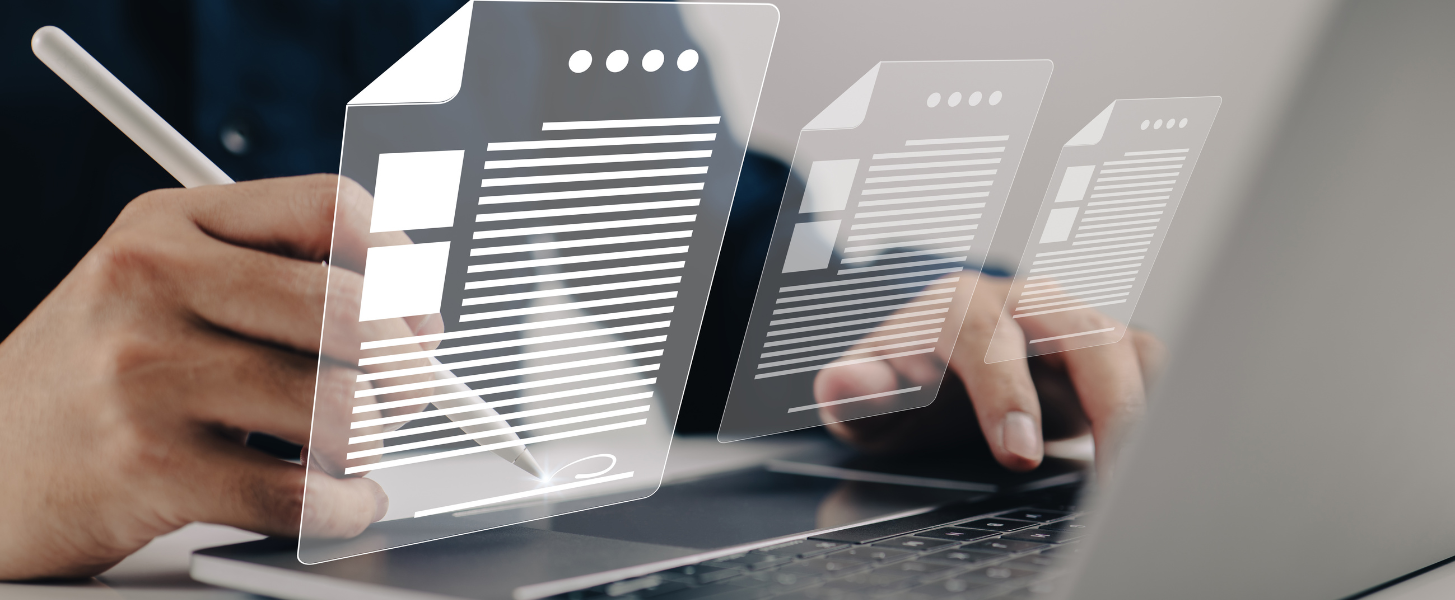The lease abstraction process plays a crucial role in commercial real estate (CRE), transforming dense legal agreements into concise, accessible summaries that drive critical business decisions. Lease managers are essential in efficiently navigating and managing complex lease agreements. However, traditional lease abstraction methods are time-consuming, error-prone, and often lack standardization—posing major operational and financial risks. Complex documents, such as lengthy commercial real estate contracts, create challenges that technology can help overcome. As the CRE industry embraces digital transformation, technology is emerging as a game-changer in simplifying, accelerating, and optimizing lease abstraction workflows.
This blog explores how innovative lease abstraction services and technologies like artificial intelligence (AI), machine learning (ML), automation, cloud-based platforms, and integrated lease management tools are revolutionizing lease abstraction. We will examine the key benefits, practical applications, challenges, and best practices for leveraging technology to streamline lease abstraction in commercial real estate.
What Is Lease Abstraction and Why Does It Matter?
Lease abstraction is the process of extracting relevant lease information from commercial lease agreements and summarizing it in a standardized format. Key information, such as terms, financial obligations, and contact details, is crucial for efficient lease management and decision-making. Abstracts typically include details such as:
- Lease term and renewal options
- Base rent and escalation clauses
- CAM (Common Area Maintenance) charges
- Security deposit and payment terms
- Tenant and landlord obligations
- Termination rights and exclusivity clauses
- Insurance and compliance requirements
This summarized data is critical for property managers, asset managers, legal teams, accountants, and brokers to ensure lease compliance, make strategic decisions, and optimize portfolio performance.
However, the abstraction process is resource-intensive and fraught with challenges—especially for companies managing large and diverse real estate portfolios.
Challenges in Traditional Lease Abstraction
1. Manual Effort and Time Consumption
Traditional lease abstraction is labor-intensive, requiring skilled professionals to read, interpret, and summarize lengthy lease documents that contain complex financial obligations, consuming valuable time. Faster processing of new leases can reduce reliance on manual efforts, streamlining workflow processes. A single lease may take hours to abstract, especially if it’s complex or includes amendments and addenda.
2. Inconsistency Across Abstracts
Lack of standardized abstraction formats can lead to inconsistencies across lease summaries, making it difficult to compare or aggregate data across a portfolio. Including the essential elements such as property addresses, landlord and tenant information, guarantors, descriptions of premises, and lease dates in a uniform format is crucial for efficient comparison of multiple leases.
3. Difficulty in Scaling Operations
As the volume of lease documents grows, managing numerous leases in-house becomes increasingly unmanageable without significant investments in personnel and training.
How Technology Is Transforming Lease Abstraction
1. Artificial Intelligence and Machine Learning
AI and ML technologies, through AI lease abstraction, are enabling machines to “read” and interpret lease documents much like a human would—but faster and with greater consistency.
Key Capabilities:
- Natural Language Processing (NLP): NLP allows AI models to understand legal language and extract key clauses and data points from leases.
- Automated Clause Detection: Algorithms can identify specific clauses (e.g., rent escalation, force majeure) and tag them for abstraction.
- Smart Validation: AI tools can cross-check extracted data against predefined templates and flag inconsistencies.
2. Optical Character Recognition (OCR)
OCR technology converts scanned lease PDFs and images into searchable and editable text. This is particularly useful for digitizing legacy lease documents that exist only in hard copy.
3. Lease Abstraction Software Platforms
Several lease abstraction software platforms now offer end-to-end solutions that combine AI, OCR, data validation, and user-friendly interfaces, often utilizing a lease abstract template to organize essential information from lease contracts into a standardized format.
Features Include:
- Pre-built lease abstraction templates
- Data extraction dashboards
- Document management
- Collaboration tools for internal and external teams
- Integration with lease administration and accounting platforms (e.g., Yardi, MRI, Lease Harbor)
4. Cloud-Based Collaboration
Cloud infrastructure enables secure access to lease documents, abstracts, and workflows from anywhere. This is especially valuable for remote teams or global operations, promoting seamless collaboration and version control.
5. Robotic Process Automation (RPA)
RPA tools can automate repetitive tasks such as:
- Renaming and sorting lease documents
- Uploading data into lease administration systems
- Sending alerts for missing clauses or incomplete data
Benefits of Leveraging Technology for Lease Abstraction
Modernizing lease abstraction through technology offers a wide array of benefits that impact not only lease management but also the broader strategic and financial performance of a commercial real estate (CRE) organization. From increased efficiency to enhanced portfolio visibility, technology brings tangible improvements across the board.
1. Enhanced Speed and Operational Efficiency
One of the most immediate benefits of leveraging technology is the significant acceleration of the abstraction process, driving operational excellence by enhancing efficiency and productivity.
- AI-powered extraction tools can review and extract key lease data points in minutes compared to hours or even days with manual processing.
- Bulk processing capabilities allow teams to abstract multiple leases simultaneously, which is invaluable during property acquisitions or portfolio audits.
- Automated workflows reduce the need for repetitive manual tasks such as data entry, clause tagging, and cross-referencing with templates.
This increase in speed translates into faster decision-making, reduced time to revenue, and improved responsiveness to lease-related inquiries.
2. Improved Accuracy and Reduced Risk of Errors
Human error is one of the most critical risks in traditional lease abstraction—especially when dealing with complex, multi-page lease agreements. To maintain compliance with accounting standards such as ASC 842, IFRS 16, and GASB 87, it is essential to minimize these risks.
- Machine learning algorithms trained on thousands of lease documents can achieve high accuracy in identifying and extracting key clauses.
- Validation mechanisms within technology platforms can automatically flag inconsistencies or missing data points, ensuring each abstract is complete and reliable.
- Consistency across abstracts is achieved through standardized templates and predefined data fields, reducing interpretational variance between abstractors.
Improved accuracy directly lowers the risk of costly mistakes such as incorrect financial terms, rent billing, missed renewals, or misinterpreted legal obligations.
3. Scalability for Growing Portfolios
As commercial real estate portfolios expand—whether through organic growth or acquisitions—the volume and complexity of leases increase accordingly, highlighting the importance of streamlining lease management for the entire lease portfolio. Technology helps organizations scale abstraction efforts without a proportional increase in staffing or costs.
- AI-driven abstraction solutions can handle thousands of leases without the limitations of manual capacity.
- Cloud-based systems support collaborative access for teams across locations, making it easier to manage decentralized portfolios.
- Built-in document management features allow abstraction of new amendments, renewals, and lease changes in real-time, keeping data current.
Scalability ensures that as your business grows, your lease data management infrastructure can keep up seamlessly.
4. Cost Savings and Operational Optimization
While implementing new technology involves upfront investment, the return on investment (ROI) becomes apparent through:
- Reduced labor costs due to less reliance on manual abstractors.
- Fewer legal and financial errors that can result in significant penalties or lost revenue.
- Faster portfolio integration during acquisitions or divestitures, reducing deal closure times.
- Lower overhead as cloud-based tools eliminate the need for physical file storage or excessive printing.
- Improved cash flow by managing expenses and maximizing rental income through strategic lease agreements.
By optimizing workflows and automating routine tasks, organizations can reallocate resources to more strategic functions.
5. Real-Time Access to Critical Lease Data
The lease abstract data, including important dates, once stored in cloud-based systems or integrated lease management platforms, becomes instantly accessible to stakeholders.
- Property managers can quickly access clauses related to maintenance obligations or insurance requirements.
- Finance teams can pull rent escalation and CAM reconciliation data for budgeting and forecasting.
- Legal teams can search and compare exclusivity or termination clauses across multiple properties.
This centralized, on-demand access to accurate lease information enhances organizational agility and transparency, particularly in fast-paced environments.
6. Better Decision-Making with Actionable Insights
Technology not only extracts and stores lease data but can also analyze it to deliver strategic insights, enhancing decision making processes.
- Dashboards and reporting tools provide portfolio-wide analytics—identifying trends, upcoming critical dates, or risk exposure.
- Predictive analytics can highlight opportunities for lease renegotiations, underutilized spaces, or high-performing locations.
- AI-driven insights allow for more informed financial modeling, improving leasing strategy and capital planning.
By turning raw lease data into actionable intelligence, technology empowers more confident, data-driven decision-making.
7. Streamlined Compliance and Audit Readiness
Regulatory compliance, audit preparedness, and lease obligations accuracy are critical in CRE. Simplifying the contract review process is essential as it aids in summarizing key legal provisions, making it easier for legal practitioners to conduct thorough evaluations. Technology supports these functions by:
- Enabling automated tracking of regulatory requirements (e.g., insurance, tax obligations).
- Ensuring version control and full documentation of every lease change or amendment.
- Providing audit trails and document histories that support due diligence and internal audits.
With everything traceable, searchable, and stored in an organized format, audit processes become faster, less stressful, and more accurate.
8. Seamless Integration with Other Systems
Modern lease abstraction platforms can integrate directly with other core business tools such as:
- Lease administration systems like Yardi, MRI, Lease Harbor
- ERP platforms for financial synchronization
- Document repositories like SharePoint or Dropbox
- Workflow automation tools for task routing and notifications
Such integrations ensure that lease data flows seamlessly throughout the organization, enhancing strategic decision making by reducing silos and increasing cross-functional efficiency.
9. Standardization Across the Organization
By using pre-set abstraction templates, clause libraries, and defined processes, organizations can ensure that key elements of lease data are collected and reported uniformly—regardless of who is performing the task or where.
- Reduces variability across internal teams or external service providers.
- Allows for apples-to-apples comparisons across different lease agreements.
- Makes training easier and ensures consistency in performance and quality.
Standardization simplifies reporting, analytics, and compliance efforts across your real estate operations.
10. Future-Readiness and Competitive Advantage
As the commercial real estate industry continues to digitize, early adopters of lease abstraction technology are better positioned to make informed decisions and:
- Respond quickly to market opportunities and tenant needs.
- Meet increasing demands for transparency and data governance.
- Maintain business continuity even amid disruptions like pandemics, remote work shifts, or regulatory changes.
Organizations that invest in tech-driven lease abstraction now will have a first-mover advantage in optimizing their portfolios and service delivery in the future.

Use Cases of Technology in Lease Abstraction
1. Portfolio Onboarding
When acquiring new properties or merging portfolios, rapid lease abstraction is essential to identify and document key lease terms, including lease duration. AI tools help expedite onboarding by quickly digesting and summarizing dozens or hundreds of leases.
2. CAM Reconciliation Support
Precise abstraction of CAM clauses allows property managers to properly allocate operating expenses and reconcile CAM charges with tenants.
3. Audit Preparation
During audits, having clean, standardized lease abstracts ensures quick access to key terms and obligations, reducing the risk of non-compliance. A comprehensive examination of lease agreements is crucial for accurately capturing all relevant information, ensuring a deep understanding of the lease’s terms, conditions, and potential concerns.
4. Renewal and Option Management
Technology can track critical dates like lease expirations, renewal notice periods, and rights of first refusal, alerting teams in advance to take timely action.
5. Lease Compliance Monitoring
By integrating abstracted data with lease management systems, teams can monitor compliance with co-tenancy clauses, insurance requirements, and maintenance responsibilities by ensuring all relevant information is accurately captured and summarized.
Best Practices for Implementing Technology in Lease Abstraction
1. Choose the Right Technology Stack
Not all tools are created equal. Evaluate platforms based on:
- Accuracy of AI models
- Lease type compatibility (retail, office, industrial, etc.)
- Integration capabilities with existing systems
- Data security and compliance
2. Invest in Quality Data Training
AI models improve with better data. Train your abstraction engine using actual leases from your portfolio to enhance extraction accuracy.
3. Adopt a Hybrid Approach
Use a human-in-the-loop approach where AI performs the initial abstraction and trained professionals validate the results. This balance ensures speed and accuracy.
4. Standardize Abstraction Templates
Establish company-wide templates to ensure uniformity across all lease abstracts. This enables easier comparison and analytics.
5. Ensure Data Security and Compliance
Lease data is sensitive. Ensure any abstraction tool used complies with industry regulations (e.g., GDPR, SOC 2) and includes robust data encryption, access control, and audit trails.
6. Train Teams and Stakeholders
Technology adoption requires change management for all real estate professionals . Train legal, leasing, finance, and property management teams on how to use the abstraction tools effectively.
Common Pitfalls to Avoid
- Over-reliance on automation: Even the best AI models need human review. Avoid treating AI outputs as final without validation.
- Lack of clear abstraction objectives: Determine what data points are essential for your organization before configuring your system.
- Inadequate data governance: Without proper workflows, version control, and access rules, digital lease abstraction can still result in chaos.
Future Trends in Lease Abstraction Technology
1. Generative AI for Clause Drafting and Interpretation
Generative AI may soon help draft lease clauses or explain complex lease language in plain English.
2. Integration with Blockchain for Smart Leases
Blockchain may provide tamper-proof storage of lease data and support smart contracts that auto-execute lease terms based on predefined triggers.
3. Predictive Analytics
By analyzing abstracted data, AI can forecast lease expirations, identify underperforming properties, and suggest portfolio optimizations.
4. Voice and Chatbot Interfaces
Property managers might soon be able to query lease data via voice assistants or chatbots—“When does Tenant X’s lease expire?”—and get instant answers.

The Human Touch: Why Quality Assurance Still Needs Experts
While artificial intelligence and automation have revolutionized lease abstraction, human expertise remains irreplaceable in ensuring accuracy, context, and legal compliance. AI can process large volumes of data quickly and identify patterns, but it doesn’t always grasp nuance, intent, or legal complexity with 100% precision.
1. Interpreting Legal Language and Ambiguity
Lease agreements often contain complex legal terminology, industry-specific jargon, or negotiable clauses with subtle nuances.
- AI may misinterpret provisions that are context-sensitive or written in a non-standard format.
- Certain clauses—such as “go-dark” provisions, co-tenancy, or use restrictions—require a trained eye to interpret accurately.
- Only experienced lease professionals can discern intent versus literal language, ensuring that abstracted data reflects the real business obligations.
2. Validating Clause Relevance and Application
Not all extracted data points are relevant or applicable across every lease. AI might surface a clause that exists in the document but is no longer valid due to an amendment or superseding language.
- Human reviewers can determine whether certain clauses are obsolete, conditional, or in conflict with other terms.
- Expert abstractors can flag inconsistencies, clarify missing information, and ensure data accuracy before it’s ingested into lease management systems.
3. Ensuring Compliance with Internal Standards
Every organization has specific templates, naming conventions, and compliance requirements for lease abstraction.
- Humans can customize abstract output to match internal reporting formats, decision-making needs, or jurisdictional differences.
- AI tools must be trained, but human abstractors can adapt more quickly to non-standard document formats or evolving business policies.
4. Providing a Layer of Accountability
Technology improves efficiency, but final responsibility still lies with people.
- Legal teams, finance officers, and property managers need to trust the data being used for key decisions.
- Having a human-in-the-loop (HITL) quality assurance process instills confidence that the abstraction has been reviewed, verified, and approved.
5. Training and Improving the AI
Human feedback is also critical for training machine learning algorithms.
- Human validators help the AI learn from errors, edge cases, and uncommon lease structures.
- Ongoing human involvement ensures that abstraction tools continuously improve and evolve with the market.
Final Thought: Humans and AI Together Offer the Best of Both Worlds
The most successful lease abstraction strategies are those that combine automation with human expertise. Technology accelerates the process and reduces costs, while humans ensure accuracy, context, and accountability. Rather than replacing abstractors, AI empowers them to focus on high-value, judgment-based tasks, improving the overall quality and strategic value of the abstraction process.
Lease abstraction is the backbone of effective lease administration, portfolio management, and compliance in commercial real estate. As lease portfolios grow more complex, traditional manual methods simply can’t keep up. By leveraging cutting-edge technologies—AI, OCR, cloud platforms, and automation—organizations can radically improve the speed, accuracy, and efficiency of lease abstraction.
The key lies in selecting the right tools, adopting best practices, and maintaining a balance between automation and human oversight. For CRE professionals looking to stay competitive, embracing technology in lease abstraction is not just a smart move—it’s a strategic imperative.
Need Help with Technology-Driven Lease Abstraction?
Whether you’re onboarding a new portfolio or looking to modernize your lease operations, our expert team can help you implement the right tools and processes. Contact us today to streamline your lease abstraction with confidence.


